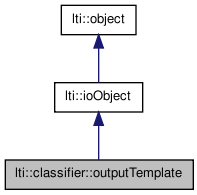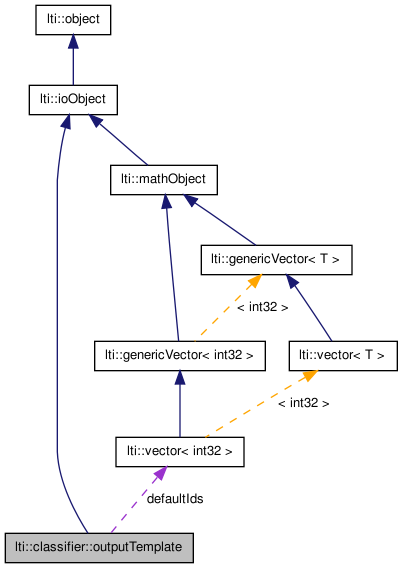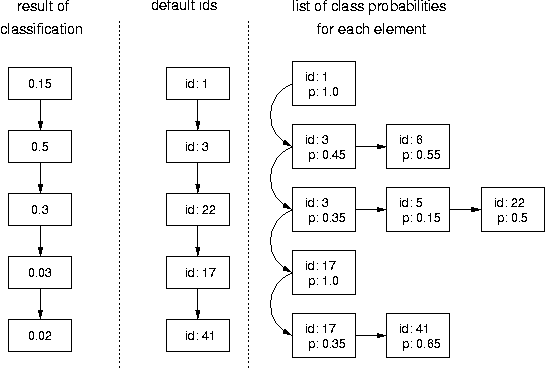

|
latest version v1.9 - last update 10 Apr 2010 |
|
The outputTemplate stores the relation between the different positions (sometimes called internal ids) of a classification result and the ids. More...
#include <ltiClassifier.h>


Public Types | |
| enum | eMultipleMode { Ignore = 0, Max, Uniform, ObjProb } |
Public Member Functions | |
| outputTemplate () | |
| outputTemplate (const outputTemplate &other) | |
| outputTemplate (const ivector &theIds) | |
| outputTemplate (const int &size) | |
| outputTemplate & | copy (const outputTemplate &other) |
| outputTemplate & | operator= (const outputTemplate &other) |
| outputTemplate * | clone () const |
| void | setMultipleMode (const eMultipleMode &mode) |
| eMultipleMode | getMultipleMode () const |
| bool | setIds (const ivector &theIds) |
| const ivector & | getIds () const |
| bool | setProbs (const int &pos, const ivector &theIds, const dvector &theValues) |
| bool | setProbs (const int &pos, const outputVector &outV) |
| const outputVector & | getProbs (const int &pos) const |
| bool | setData (const int &pos, const int &realId, const outputVector &outV) |
| int | size () const |
| bool | apply (const dvector &data, outputVector &result) const |
| bool | write (ioHandler &handler, const bool complete=true) const |
| bool | read (ioHandler &handler, const bool complete=true) |
Protected Attributes | |
| eMultipleMode | multipleMode |
| std::vector< outputVector > | probList |
| ivector | defaultIds |
The outputTemplate stores the relation between the different positions (sometimes called internal ids) of a classification result and the ids.
Applying the outputTemplate to such a vector results in an outputVector which is not to be confused with the classification result.
There are two data structures within the outputTemplate storing the relevant data:
The calculation of the outputVector using the apply method depends on the value of the parameter multipleType, which is of type eMultipleType. The following settings are available:
As mentioned above for all cases but Ignore, the outputTemplate contains a list of class probabilities for each element of the classification result. These are interpreted as dependent probablities: P(o|x) where o stands for the id and x for the position in the classification result. Each element of the classification results is also taken as a probability p(x). Thus the values for each id are calculated as  .
.
Here is a short example for the behavior of an outputTemplate when applied to a classification result. The figure shows the classification result on the lefthand side, the default ids which are used with the option Ignore in the middle and the probabiltity lists which are used for Max, Uniform and ObjProb on the righthand side.

Depending on the value of multipleMode the following outputVector is generated by calling apply:
1 | 3 | 5 | 6 | 17 | 22 | 41 | |
Ignore | 0.15 | 0.50 | --- | --- | 0.03 | 0.30 | 0.02 |
Max | 0.15 | --- | --- | 0.50 | 0.03 | 0.30 | 0.02 |
Uniform | 0.15 | 0.35 | 0.10 | 0.25 | 0.04 | 0.10 | 0.01 |
ObjProb | 0.15 | 0.33 | 0.05 | 0.27 | 0.04 | 0.15 | 0.01 |
If the use of all four options is desired, the constructor outputTemplate(int) receiving an int value must be used. All data can be set using methods setIds, setProbs and/or setData. If the other constructors are used, no space is reserved for the lists of probabilities, since these take much space and some, especially unsupervised, classifiers do not need or have no means to gather this information.
This type specifies how the output element probability and the probabilities in the list should be combined.
See description of outputTemplate.
| lti::classifier::outputTemplate::outputTemplate | ( | ) |
Default constructor.
multipleMode is ObjProb.
| lti::classifier::outputTemplate::outputTemplate | ( | const outputTemplate & | other | ) |
Copy constructor.
| lti::classifier::outputTemplate::outputTemplate | ( | const ivector & | theIds | ) |
Constructor.
Since a vector of ids is given multipleMode is Ignore and the probability lists are not initialized and thus cannot be set later.
| lti::classifier::outputTemplate::outputTemplate | ( | const int & | size | ) |
Constructor.
The number of output units is given. multipleMode is ObjeProb. Default ids as well as lists of probabilities can be set.
| bool lti::classifier::outputTemplate::apply | ( | const dvector & | data, | |
| outputVector & | result | |||
| ) | const |
Uses the information stored in the outputTemplate to generate an outputVector from a dvector.
See description of outputTemplate for details. The classification result should contain only positive values which are greater for better fit. The best interpretability is obtained if data is a probability distribution.
| data | the classification result | |
| result | outputVector calculted using the outputTemplate. |
| outputTemplate* lti::classifier::outputTemplate::clone | ( | ) | const |
clone
| outputTemplate& lti::classifier::outputTemplate::copy | ( | const outputTemplate & | other | ) |
| const ivector& lti::classifier::outputTemplate::getIds | ( | ) | const |
Returns a const reference to the id vector.
Referenced by lti::kNNClassifier::getColumnId().
| eMultipleMode lti::classifier::outputTemplate::getMultipleMode | ( | ) | const |
Get the setting of multipleMode.
| const outputVector& lti::classifier::outputTemplate::getProbs | ( | const int & | pos | ) | const |
Returns a const reference to the probability distribution at the given position of the template.
| outputTemplate& lti::classifier::outputTemplate::operator= | ( | const outputTemplate & | other | ) | [inline] |
assigment operator (alias for copy(other)).
| other | the outputTemplate to be copied |
Reimplemented from lti::ioObject.
References copy().
| bool lti::classifier::outputTemplate::read | ( | ioHandler & | handler, | |
| const bool | complete = true | |||
| ) | [virtual] |
read the outputTemplate from the given ioHandler
| handler | the ioHandler to be used | |
| complete | if true (the default) the enclosing begin/end will be also written, otherwise only the data block will be written. |
Reimplemented from lti::ioObject.
| bool lti::classifier::outputTemplate::setData | ( | const int & | pos, | |
| const int & | realId, | |||
| const outputVector & | outV | |||
| ) |
Set the probabilities and the default id of one unit.
This information must be set for all elements of the classification result. Then is can be used by the apply method for any value of multipleMode.
| pos | the posision in the classification result this distribution is for. | |
| realId | the expected or desired id of this posision of the classification result. | |
| outV | list of ids and corresponding probabilities of classes possibly correct, when this position has high probability. |
| bool lti::classifier::outputTemplate::setIds | ( | const ivector & | theIds | ) |
Set the default id vector.
These are used when multipleMode is set to Ignore.
| void lti::classifier::outputTemplate::setMultipleMode | ( | const eMultipleMode & | mode | ) |
Change the setting of how the object probabilities of each unit are taken into account when calculating the outputVector.
See description of outputTemplate.
| bool lti::classifier::outputTemplate::setProbs | ( | const int & | pos, | |
| const outputVector & | outV | |||
| ) |
Set the probabilities of one unit.
This information must be set for all elements of the classification result. Then is can be used by the apply method when multipleMode is set to one of Max, Uniform or ObjProb.
| pos | the posision in the classification result this distribution is for- | |
| outV | list of ids and corresponding probabilities of classes possibly correct, when this position has high probability. |
| bool lti::classifier::outputTemplate::setProbs | ( | const int & | pos, | |
| const ivector & | theIds, | |||
| const dvector & | theValues | |||
| ) |
Set the probabilities of one unit.
This information must be set for all elements of the classification result. Then is can be used by the apply method when multipleMode is set to one of Max, Uniform or ObjProb.
| pos | the posision in the classification result this distribution is for- | |
| theIds | list of ids of classes possibly correct, when this position has high probability. | |
| theValues | probabilities of each of these ids. |
| int lti::classifier::outputTemplate::size | ( | ) | const |
returns the number of output units handled by this outputTemplate
| bool lti::classifier::outputTemplate::write | ( | ioHandler & | handler, | |
| const bool | complete = true | |||
| ) | const [virtual] |
write the outputTemplate in the given ioHandler
| handler | the ioHandler to be used | |
| complete | if true (the default) the enclosing begin/end will be also written, otherwise only the data block will be written. |
Reimplemented from lti::ioObject.
ivector lti::classifier::outputTemplate::defaultIds [protected] |
List of ids for each output unit.
Determines what data is used for calculation of an outputVector from the classification result and the outputTemplate.
See eUseObjectProb and outputTemplate for detailed description.
std::vector<outputVector> lti::classifier::outputTemplate::probList [protected] |
Contains one outputVector for each output unit.
These hold the probabilities for the ids being correct when this unit is activated.